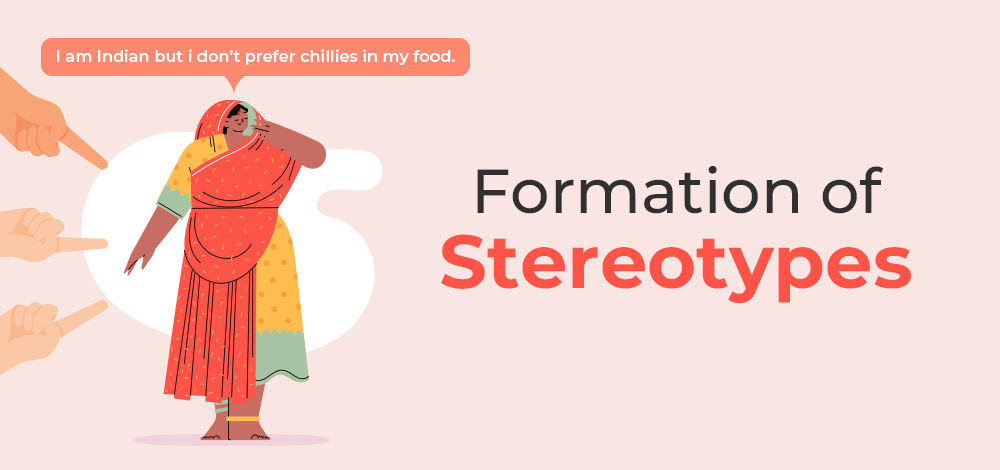Formation of a Stereotype
Last Updated :
15 Jan, 2024
A stereotype is a generally held, oversimplified, and exaggerated attitude about a certain group of people. People’s perceptions of a group are based on features that are frequently not reflective of the group as a whole, creating a mental image of that group.

Formation of Stereotypes
Stereotypes
Stereotyping is the process of drawing judgments about people based on their membership in a particular group rather than their individual characteristics and qualities. It is difficult to recognize and understand the intricacy of many different persons and groups, which can lead to bias and discrimination.
Formation of Stereotypes and Stereotyping
Stereotypes and stereotyping are created and reinforced by a variety of factors. Among the crucial elements are:
- Socialization: Stereotypes are passed down to individuals by their family, peers, the media, and cultural influences, which can mold their attitudes and views towards various groups.
- Limited Exposure: Due to limited exposure to a group, stereotypes may emerge, which can lead to an oversimplification and generalization of the qualities and characteristics of that group.
- Confirmation Bias: It is the tendency for people to seek out information that supports their preexisting ideas and stereotypes while ignoring information that deviates from those beliefs and stereotypes.
- Prejudice: Stereotypes can result in prejudice, which is an unfavorable viewpoint towards a specific group, and discrimination, which is the unfair treatment of people based on their membership in a particular group.
- Ingroup and Outgroup Biases: Perceiving members of one’s own group as more diverse and individualistic, while perceiving members of other groups as more similar and homogeneous.
- Representation in Media: Seeing limited and stereotypical portrayals of certain groups in television, film, and news media.
- Historical Events and Systemic Oppression: Passed down experiences and beliefs from past generations about certain groups, perpetuated by discriminatory practices and policies.
Stereotyping is a subtle and pernicious phenomenon that can have harmful, far-reaching effects. In order to build a more inclusive and equitable society, it is crucial to recognize and combat our own biases.
Political Scenario of Stereotyping
Political stereotyping refers to the practice of making assumptions about an individual or a group of individuals based on their political affiliations, ideologies, or viewpoints. This form of stereotyping may still be employed by politicians, the media, and other sources, which can be harmful to political discourse and decision-making.
Political stereotyping can result in conflict and polarisation because it categorizes and labels individuals or groups based on their political beliefs rather than their distinctive qualities and characteristics. Also, this can further marginalize some communities and feed prejudices against them.
Political stereotyping can also make it more challenging for people to engage in meaningful and constructive discussions because it reduces their willingness to hear and consider the opinions of those who hold different political ideologies. It is crucial for people and leaders to be aware of and question their own prejudices in order to foster a more courteous and inclusive political debate that acknowledges the diversity of opinions and ideas.
Stereotypes may be encouraged by both national and international politics. Politicians and media organizations may stereotype people based on their race, ethnicity, religion, nationality, or political ideology in order to influence public opinion, stir up fear, or further their own goals. This can intensify existing conflicts and hostility between various parties and have a long-lasting impact on domestic and global affairs. Public leaders and the media must take responsibility for the messages they convey and work to promote peace and understanding rather than creating false preconceptions.
Stereotypes in India
Stereotypes can be harmful and oversimplify a diverse range of individuals and beliefs. It’s important to avoid perpetuating stereotypes and instead engages in thoughtful discussions that respect a range of perspectives.
With that in mind, here are some examples of stereotypes that have been associated with India:
- Indian women are submissive and oppressed: This stereotype assumes that all women in India are submissive and oppressed and that they have no agency or voice. While gender inequality and violence against women are issues in India, it is important to recognize that Indian women have made significant strides in various fields and are increasingly breaking down gender barriers.
- Indians are all tech geniuses or call center operators: This stereotype assumes that all Indians are highly skilled in the field of technology or work in call centers. While India has emerged as a global leader in the IT sector and call center outsourcing, it is important to recognize that there is a wide range of professions and skills within the country.
- All Indians are vegetarian: This stereotype assumes that all Indians are vegetarian and do not eat meat. While vegetarianism is a significant dietary choice for many Indians, it is not the only dietary option and many Indians consume meat.
- All Indians speak Hindi: This stereotype assumes that all Indians speak Hindi, which is one of the official languages of India. While Hindi is widely spoken, India has 22 official languages and over 1000 dialects, highlighting the country’s linguistic diversity.
FAQs on Formation of Stereotypes
Question 1: What is a stereotype?
Answer:
A stereotype is a widely held, oversimplified, and often prejudiced image or idea about a group of people based on limited and unrepresentative information.
Question 2: How do stereotypes form?
Answer:
Stereotypes can form through various means such as socialization, confirmation bias, ingroup, and outgroup biases, representation in media, historical events, and systemic oppression.
Question 3: Why are stereotypes harmful?
Answer:
Stereotypes can result in unjust treatment and discrimination towards members of a group and limit one’s understanding and appreciation of diversity. They can also reinforce negative and inaccurate beliefs.
Like Article
Suggest improvement
Share your thoughts in the comments
Please Login to comment...